#Theodore McKeldin
Explore tagged Tumblr posts
Text
Maryland Governor DILFs
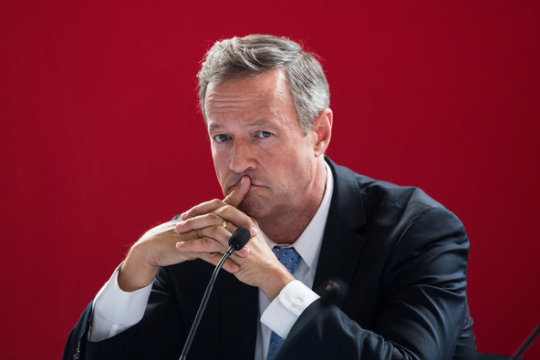
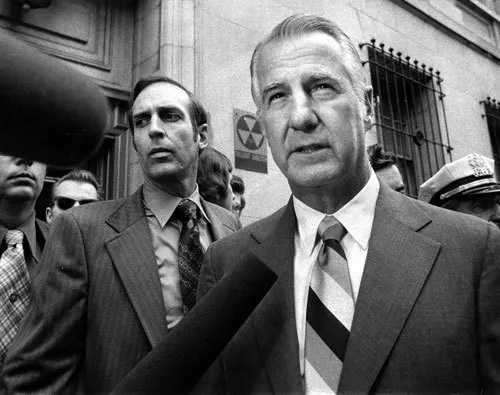


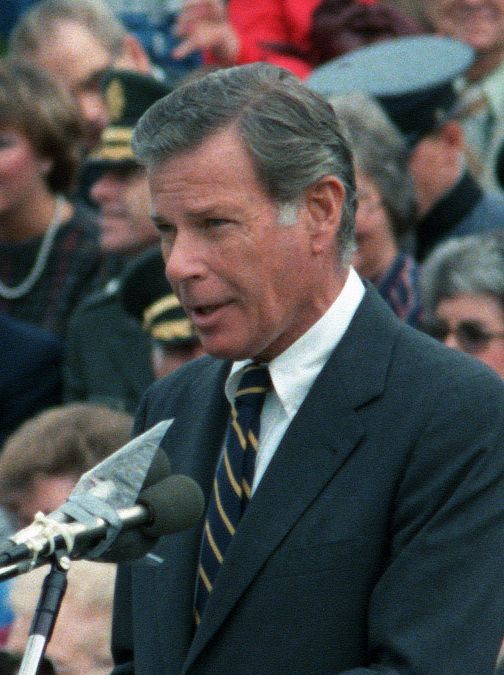
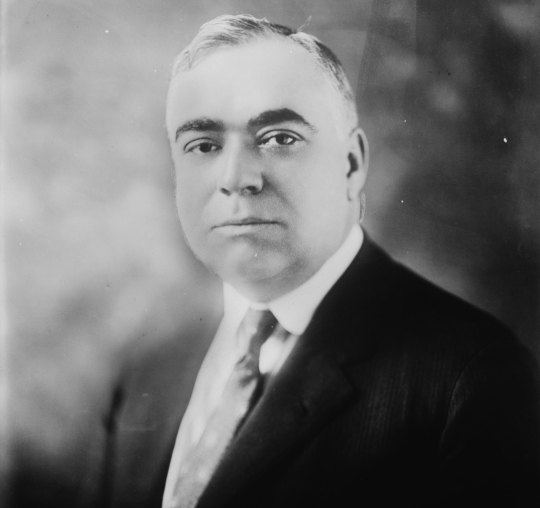



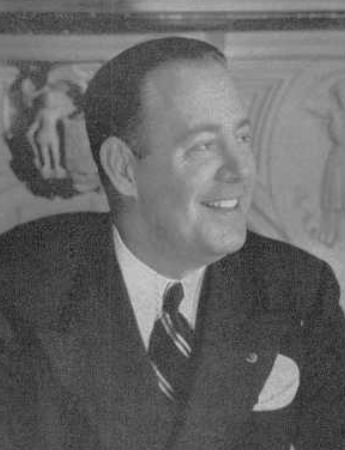




Martin O'Malley, Spiro Agnew, Blair Lee III, J. Millard Tawes, Harry Hughes, Harry Nice, William Preston Lane Jr., Marvin Mandel, Theodore McKeldin, Herbert J. O'Connor, Larry Hogan, Bob Ehrlich, Parris Glendening, William Donald Schaefer
#Martin O'Malley#Spiro Agnew#Blair Lee III#J. Millard Tawes#Harry Hughes#Harry Nice#William Preston Lane Jr.#Marvin Mandel#Theodore McKeldin#Herbert J. O'Connor#Larry Hogan#Bob Ehrlich#Parris Glendening#William Donald Schaefer#GovernorDILFs
16 notes
·
View notes
Text

0 notes
Photo

Once Upon a Time…08.18.2018
The Baltimore Jewish Times publishes unidentified photographs from the collection of Jewish Museum of Maryland each week. If you can identify anyone in these photos and more information about them, contact Joanna Church by email at [email protected]

Date run in Baltimore Jewish Times: August 18, 2017
PastPerfect Accession #: IA 1.0869
Status: Identified! Former Governor Theodore R. McKeldin (center) at the dedication of the restored Lloyd Street Synagogue, 1965. Left to right: Marty Stone (possibly); Gerson Woolf; Governor McKeldin; Frieda (Mrs. J. Max) Abramowitz; Grace (Mrs. Irving J.) Abramowitz
Thanks To: Howard Woolf and Judy Chernak
Originally posted at the Jewish Museum of Maryland blog on May 1, 2018.
#once upon a time#baltimore jewish times#museum collections#museums on tumblr#lloyd street synagogue#governor theodore mckeldin
2 notes
·
View notes
Photo
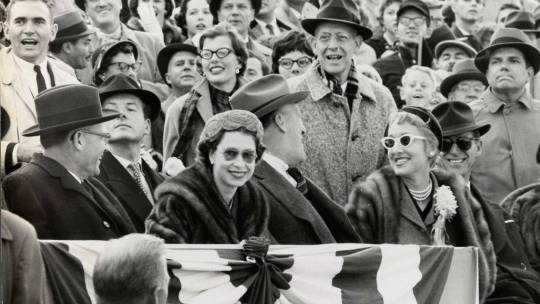
Queen Elizabeth II smiles as she sits in the stands at the football game. In her row, from left to right: UMD President Wilson Elkins, the queen, Gov. Theodore McKeldin, Dorothy Elkins, and Prince Philip, Duke of Edinburgh. President Elkins said the queen was “most interested in the difference between the English Rugby and the American game,” reported The Diamondback.
Photos courtesy of University of Maryland Archives
37 notes
·
View notes
Photo

Most Carroll County residents travel on Route 140 almost daily, however it wasn’t until July 1st, 1954 that then-Governor Theodore McKeldin visited Carroll County to officially open the last section of four lane road. To celebrate the opening, people enjoyed the traditional ribbon-cutting ceremony and a luncheon at Hoffman’s Inn at 216 East Main Street, Westminster. This image captures just some of the excitement of that day.
2 notes
·
View notes
Photo

Baltimore Inner Harbour 2013 by Greg Reed 54 Baltimore Inner Harbor The Inner Harbor is a historic seaport, tourist attraction, and landmark of the city of Baltimore, Maryland. It was described by the Urban Land Institute in 2009 as "the model for post-industrial waterfront redevelopment around the world."[1] The Inner Harbor is located at the mouth of Jones Falls, creating the wide and short northwest branch of the Patapsco River. The district includes any water west of a line drawn between the foot of President Street and the American Visionary Art Museum. The name "Inner Harbor" is used not just for the water but for the surrounding area of the city, with approximate street boundaries of President Street to the east, Lombard Street to the north, Greene Street to the west, and Key Highway on the south. The harbor is within walking distance of Camden Yards and M&T Bank Stadium. A water taxi connects passengers to Fells Point, Canton, and Fort McHenry. History While Baltimore has been a major U.S. seaport since the 18th century, the historically shallow water of the Inner Harbor (prior to manipulation through dredging) was not conducive to large ships or heavy industry. These were concentrated in Locust Point, Fell's Point, and Canton. In the mid-20th century, Baltimore suffered from the economic decline of restructuring common to many industrial cities in the United States. Old harbors were abandoned with the arrival of container ships after World War II. Later, the old harbors were adapted as focal points to reconnect cities with their waterfronts, and develop public spaces, tourism, business, and housing.[2] During the 1940s, John H. Threadgill, the head of the Steamship Trade Association, initiated a study for a cross-harbor bridge.[3] A bridge across the Inner Harbor of Baltimore was one idea that was discussed frequently. In his capacity as head of the association, Threadgill ultimately recommended that the idea for a cross-harbor bridge be abandoned, due to the fact that Baltimore relied heavily on a shipping trade and fears that the bridge would negatively impede the flow of shipping traffic at the Port of Baltimore.[4] Threadgill was named head of Baltimore's Port Commission during the 1950s.[5] In the 1950s, economic changes ended both the freight and passenger use of the Inner Harbor, such as the Old Bay Line's steamers. Rotting warehouses and piers were eventually torn down and replaced by open, grass-covered parkland that was used for recreational purposes and occasional large events. The waterfront was gradually transformed with award-winning parks and plazas surrounded by office buildings, hotels and leisure attractions, which reversed the city's decline and became a model for urban renaissance in cities around the world.[6] The renewal of Baltimore's Inner Harbor area began with the adoption of the 33-acre (13 ha) Charles Center project by the City Council and Mayor Thomas D'Alesandro in March 1958. Between 1958 and 1965, Baltimore renewed the center of its business district by rebuilding Charles Center with office buildings, hotels, and retail shops. At the beginning of mayor Theodore R. McKeldin's second term in 1963, the redevelopment program was expanded to include 240 acres (97 ha) surrounding the Inner Harbor. Corporate headquarters and hotels were built around the shoreline of the Inner Harbor. A public park and promenade were added for leisure activity and community gatherings. On July 4, 1976, following the rendezvous of Tall Ships in New York for the U.S. Bicentennial, eight ships from other nations visited Baltimore, where they attracted a huge number of tourists. This interest helped spur the development of other tourist attractions – including the National Aquarium, Maryland Science Center, and the Harborplace festival marketplace (operated by The Rouse Company), which opened on July 4, 1980.[7] The nearby Baltimore Convention Center and Hyatt Regency Baltimore Hotel added to the services and resulted in population density and visitors. With the success of the Inner Harbor in the 1970s and 1980s, Baltimore became a worldwide tourist destination and model of urban planning and development. It influenced more than 100 other cities and won more than 40 national or international awards, including a citation by the American Institute of Architects in 1984 as "one of the supreme achievements of large-scale urban design and development in U.S. history."[8] In recent years, the area along the waterfront to the east of the Inner Harbor (in the direction of Fells Point and Little Italy) has been developed with condominiums, retail space, restaurants, and hotels – an ongoing project known as Harbor East. While little development land remains around the Inner Harbor, the available land has been subject to many plans, which have not been realized. Recently completed projects include mixed-use developments incorporating office space, street-level retail, and condominiums, as well as hotel projects such as the Ritz Carlton Residences, a condominium project on Key Highway at the southeast corner of the Inner Harbor. In September 2003, the Inner Harbor area was flooded by Hurricane Isabel. The Baltimore World Trade Center remained closed for a month, but all the other buildings were saved from flooding by the Inner Harbor development controls, which were created by the master developer team of Charles Center-Inner Harbor Management, Inc. In March 2004, a water taxi capsized during a storm on the Northwest Branch of the Patapsco River near Fort McHenry. While occurring over a mile downstream of the Inner Harbor, the accident was associated with the Inner Harbor by news reports and casual observers. Five passengers died in the accident, which the National Transportation Safety Board determined was caused when the small pontoon-style vessel encountered unpredictable strong winds and waves.[9] Source: en.wikipedia.org/wiki/Inner_Harbor https://flic.kr/p/2c5tRTb
1 note
·
View note
Text
The traffic cop who ruled Pratt and Light
Traffic cop William "Podge" McKeldin and his horse, Bob. That's his brother, Ted, the governor, at right, with the X through his face. (Hans Marx, Baltimore Sun, November 1952; Sun Archive, Albin O. Kuhn Library and Gallery, University of Maryland, Baltimore County)
Theodore McKeldin may have served as the mayor of Baltimore and the governor of Maryland, but there are those who would argue that his brother, Bill, was more famous, more beloved, maybe even more important to the day-to-day functioning of the city.
For 18 years, from 1937 to 1955, policeman Bill “Podge” McKeldin ruled the intersection of Pratt and Lights streets. Hat on head, boots on feet and whistle at the ready (even though he didn’t need one, so shrill was his own whistle), he directed traffic at what was, then, one of the busiest intersections in the country. Getting past Pratt and Light is no picnic now, but back then, it was truly fearsome. For one thing, the area was a busy, working port. And nearly all traffic heading north – and by north, we mean not only making for Towson, but also Philadelphia and points beyond – had to wind its way through Baltimore, and that often meant getting past Pratt and Light.
Officer McKeldin confers with a driver passing through his post, at the busy corner of Pratt and Light streets. (Hans Marx, Baltimore Sun, November 1952; Sun Archive, Albin O. Kuhn Library and Gallery, University of Maryland, Baltimore County)
Not only did Podge (a childhood nickname with origins long forgotten, apparently) direct traffic, but he did it with aplomb – standing atop a six-foot-high platform, maneuvering signs that said “STOP” and “GO,” whistling and shouting and pointing and, despite it all, maintaining a reasonably good humor. He was almost always accompanied by his horse, Bob, who would stand alongside the platform and had been trained to face in the direction of the traffic flow.
Podge became something of an institution and even cult figure, one whose reputation extended even beyond Charm City.
Once, when the officer was on sick leave, a worried truck driver, realizing something was missing from his last trip through Baltimore, wrote to ask what had happened to “the whistler at Pratt and Light.”
“He works the post as enthusiastically today as he did when he first got the hang of it,” Sun reporter Ralph Reppert wrote in a Nov. 30, 1952, profile.
Podge’s story remains a source of pride and reassurance to many Baltimoreans, even those who didn’t know him, or who don’t realize what Inner Harbor driving was like in the days before the Harbor Tunnel and the Beltway diverted traffic away from downtown. Local author Peter E. Dans, a retired internist at Johns Hopkins, has written a children’s book, “Sergeant Bill and His Horse Bob,” through which he hopes to perpetuate Podge’s story.
The story of Officer McKeldin and his horse lives on in "Officer Bill and His Horse Bob," a children's book from local author Peter E. Dans. (Handout photo)
Dans first heard about “the whistler at Pratt and Light” through a trivia question asked by Baltimore chronicler Gilbert Sandler. “As I learned more about the story, I thought it would be a fun thing to talk about,” says Dans, who had written an earlier children’s book about the peregrine falcons, Scarlett and Beauregard, who once raised a family from their perch atop Baltimore’s USF&G Building, now the Transamerica Building. He's also written several books for adults, including a survey of doctors in the movies.
Dans’ book tells the factual story of Sgt. Bill and Bob, then embellishes it with a made-up tale of how President Franklin Roosevelt once lost his little dog, Fala, while passing through town, only to have him recovered by – you guessed it – Sgt. Bill.
It’s all quite charming, with kid-friendly drawings provided by MICA-trained illustrator Mary Grace Corpus. “It’s a nice story, a positive, nice thing,” Dans says. “We could use a lot of nice stories.”
Officer McKeldin, with his brother the governor on the left, at his Pratt and Light streets post. (Hans Marx, Baltimore Sun, November 1952; Sun Archive, Albin O. Kuhn Library and Gallery, University of Maryland, Baltimore County)
Even better, Dans’ book performs a valuable civic function. Fifty-six years after Podge retired (he died 54 years ago this week, on Feb. 8, 1962), it helps explain to a new generation why old-time Baltimoreans insist the Inner Harbor’s McKeldin Fountain, which sits roughly where Podge manned his post for so many years, actually honors two people – a governor of Maryland, and his brother, the traffic cop.
Thanks to Sun researcher Paul McCardell, who is to this newsroom as Podge McKeldin was to Pratt and Light, for his invaluable help in putting this post together.
#retro baltimore#William Podge McKeldin#bill mckeldin#theodore mckeldin#ted mckeldin#baltimore police#baltimore policemen#baltimore mayor#baltimore governor#Peter E. Dans#Officer Bill and His Horse Bob#pratt street#light street#pratt and light streets#baltimore streets#baltimore intersections#baltimore roads#franklin delano roosevelt#fdr#fala#franklin d. roosevelt#Mary Grace Corpus#chris kaltenbach
3 notes
·
View notes
Video
Embed from Getty Images
getty
MARCH 19, #onthisday in 1957 (58 years ago): High school students, Senator Harry Cole and former Baltimore City Mayor Theodore McKeldin during a hearing of a civil rights bill, Annapolis, Maryland, March 19, 1957. (Photo by Afro American Newspapers/Gado/Getty Images). @gettyimagesarchive More photos at http://www.projectgado.org/depthoffield
#History#Historical Photo#Baltimore City#Theodore McKeldin#Harry Cole#ARC0001078#10759final#Horizontal#Black And White#North America#USA#Maryland#Annapolis#Bill#Hearing#People#Civil Rights#Student#Human Interest#Former#High School
0 notes
Photo

Queen Elizabeth II and Maryland Governor Theodore R. McKeldin at the 1957 UNC vs. Maryland football game, held in College Park, MD.
21 notes
·
View notes
Photo

Governor [Theodore R.] McKeldin, Marse Callaway, and Carl Murphy February 1951 Paul S. Henderson (1899—1988) 4 x 5 inch black and white negative Paul Henderson Photograph Collection, ca. 1940-1960 Maryland Historical Society HEN.00.B1-069
Occupy Baltimore is taking place at McKeldin Square as of yesterday, following many other occupied movements around the country. Read about Theodore McKeldin (1900-1974) in this newspaper article featured on the Maryland State Archives website.
Marse S. Callaway was a successful African American politician and businessman (including real estate). Callaway moved to Baltimore in 1917.
Carl Murphy (1889-1967) was the son of John Henry Murphy, Sr., founder of the Afro-American newspaper. He became editor-publisher of the paper after his father's death in 1922 and helped build the Maryland branch of the National Association for the Advancement of Colored People (N.A.A.C.P.).
#Theodore McKeldin#Mayor McKeldin#Governor McKeldin#Marse Callaway#Carl Murphy#Paul Henderson#Maryland Historical Society#Henderson#Photograph#History#Politics#Historic photograph#digital preservation#Henderson Collection#Baltimore City Life Museum#McKeldin Square#Afro-American newspaper#African American history
7 notes
·
View notes
Photo

Happy #ThrowbackThursday from the JMM Collections! Proclamation by Mayor Theodore R. Mckeldin designating the week of November 1 through November 8, 1966 as Horseradish week in Baltimore. JMM 1998.18.8
Enjoy a few other items from the collections to celebrate a week of horseradish!:

Baltimore City street sign for "Horseradish Lane," removed when the street was renamed Salisbury Alley, JMM 1985.160.1

Rabbi Max checking Tulkoff's horseradish plant on Lombard Street for kosher certification; Martin Tulkoff stands to the right, c. 1981, JMM 1990.41.4

Unused labels for Tulkoff's famous "Tiger Sauce," c.1960s, JMM 1998.18.7
And a little business history: Harry Tulkoff, born in Bobroisk, Russia, emigrated to the United States as a teenager and founded Tulkoff's in Baltimore as a produce stand, specializing in supplying caterers with frest fruits and vegetables.
By 1930, their horseradish became so popular that the Tulkoffs made it their exclusive product, under the name Tulkoff Horseradish Products Company. Claiming up to 75% of market share for horseradish products in the United States, and run by many members of the Tulkoff family, Tulkoff's expanded its product line to include prepared white and red horseradish, Tiger Sauce, and horseradish mustard.
Most of Tulkoff's horseradish is grown in Maryland!
#throwback thursday#horseradish week#tulkoff's#museums on tumblr#museum collections#horseradish#tiger sauce#baltimore history#jewish history#chosen food
7 notes
·
View notes
Photo
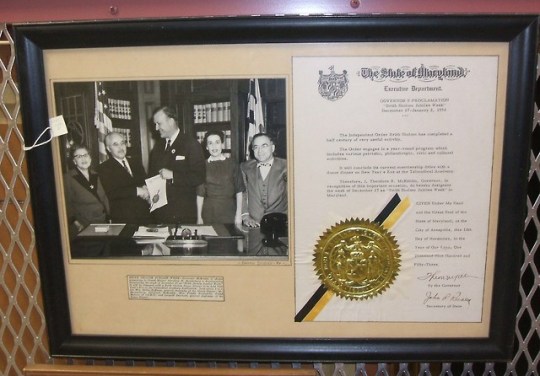
#ThrowbackThursday from the JMM Collections:
Proclamation, week of December 27, 1954: “Brith Sholom Jubilee Week,” signed by Governor Theodore McKeldin.
Photo also includes Abraham H. Mandelberg, Mollie Roffman, Frieda Buckowitz, and Leopold Jacobson. Brith Sholom Records Collection, JMM 1995.209.61a. #TBT
2 notes
·
View notes
Text
Calvin Ball wins in Howard County; Frosh, Franchot re-elected
The governor's race always attracts the most attention, but many other positions across Maryland were also on the ballot in Tuesday's election. Seats in the General Assembly, U.S. Senate, Congress and many statewide and county positions were among those at stake. Gov. Larry Hogan's re-election marks a major victory for Republicans in Maryland. He became the first Republican governor to consecutive terms in the deep-blue state since Theodore McKeldin in the 1950s. But Democrats dominated elections…
from https://www.bizjournals.com/baltimore/news/2018/11/06/calvin-ball-wins-in-howard-county-frosh-franchot.html?ana=RSS&s=article_search
0 notes
Text
McKeldin Plaza debuts without the fountain
Just in time for the summer solstice, the new-look McKeldin Plaza at the Inner Harbor will reopen Thursday at 11 a.m. The triangle-shaped green space at South Light and Pratt streets has been undergoing a redevelopment over the past four months that included demolition of the Brutalist-style McKeldin Fountain, named after Theodore McKeldin, the city's former mayor who later became governor of Maryland. The new space has sculptures, outdoor lighting, park benches and new landscaping. Planning began…
from http://www.bizjournals.com/baltimore/news/2017/06/20/mckeldin-plaza-debuts-without-the-fountain.html?ana=RSS%26s=article_search
0 notes
Text
A St. Patrick’s Day tradition, revived
The 1956 incarnation of Baltimore's St. Patrick's Day Parade marches along Cathedral Street. (Ralph Dohme, Baltimore Sun files, March 17, 1956)
After a lapse of nearly half-a-century, 1956 saw the Irish eyes of Baltimore smiling once again, as the city’s St. Patrick’s Day Parade returned in all its emerald-green glory.
“It was a great day for you-know-who and a splendid one for the wearin’ o’ the you-know-what-color-we-refer-to,” read a gleeful account of the St. Patrick’s celebration in the March 18 editions of The Sun. “It was plain to see that the you-know-what-kind-of-eyes were smiling.”
To mark the day, luncheons, banquets and a dance were sponsored by the Ancient Order of Hibernians, the Hibernian Society and the year-old Friendly Sons of St. Patrick. Some 35,000-40,000 spectators lined Cathedral Street to watch the parade, the first one in the city in 46 years.
The Knights of Columbus march in Baltimore's 1956 St. Patrick's Day Parade. (Ralph Robinson, Baltimore Sun files, March 17, 1956)
Among the 50 marching groups in the parade were nurses from St. Agnes Hospital (wearing shamrock pins), students from the Institute of Notre Dame (wearing green plaid skirts, of course) and a handful of military units, dressed in “uniforms that at least were khaki – a shade of the color of the day.”
“Baltimore folk gave St. Patrick’s Day a really rousing reception,” The Sun reported.
But the parade was only the most public event of a day-long celebration of the Irish that extended throughout the city. Archbishop Keough celebrated mass at St. Patrick’s on Broadway in Fells Point.
At the Emerson Hotel on Baltimore Street (where the SunTrust Bank building now stands), Gov. Theodore McKeldin gave the keynote speech as the Hibernian Society hosted its 153rd annual St. Patrick’s Day banquet (where “everything was as appropriate as the Dublin Bay terrapin that was served”). In his speech, the governor equated the plight of Alaska and Hawaii, which at the time were U.S. territories but not yet states, with the English rule over Northern Ireland.
(He did not mean it as a compliment. “In our holding of Alaska and Hawaii at disdainful arm-lengths, we are practicing another kind of terrible tyranny,” he said.)
St. Patrick's Day mass is celebrated at St. Patrick's on Broadway. (Albert D. Cochran, Baltimore Sun files, March 17, 1956)
At the nearby Southern Hotel, the Friendly Sons of St. Patrick had their annual gala, bestowing life memberships on Evening Sun city editor Paul T. Broderick and former Gov. and U.S. Senator Herbert R. O’Conor – who enjoyed his own St. Patrick’s celebration with the birth of his grandson, Patrick Sean O’Conor.
At Bowie Race Track, a feature race was named the “St. Patrick’s Day.” At Locust Point, the captain of the Irish ship Irish Cedar took time off from his duties – the ship was loading grain destined for Dublin – to take part in the festivities.
===
For information on the 2015 St. Patrick’s Day Parade, click here.
For information on a variety of St. Patrick’s Day events around Baltimore this year, click here.
#St. Patrick's Day#theodore mckeldin#st. patrick's church#ancient hibernians#baltimore parades#st. patrick's day parade#archbishop keough#retro baltimore#herbert r. o'conor#knights of columbus
1 note
·
View note
Text
This Day in History: Feb. 25
In 1947, Mayor McKeldin held a family meeting to determine whether he would seek re-election. Mrs. McKeldin, 11-year-old Teddy and 7-year-old Clare voted unanimously against him entering the race. McKeldin did not run that year, but in 1951 he became governor of Maryland after defeating William Preston Lane Jr. McKeldin served as governor until 1959, and he became the last Republican to be elected mayor of Baltimore when he won his campaign for a second and final term as mayor in 1963. (Baltimore Sun photo, 1965)
1836: Inventor Samuel Colt patented his revolver.
1971: Three Maryland lacrosse players were elected to the National Lacrosse Hall of Fame -- Ivan Marty of University of Maryland, Fritz Stude of Johns Hopkins University and Thomas Truxton of the Naval Academy.
1973: The Stephen Sondheim musical “A Little Night Music” opened at Broadway's Shubert Theatre.
1987: Local developers and the Charles Street Management Corp. started a six-week media blitz aimed at convincing those in the Baltimore area to live downtown rather than in the suburbs. The 55-second radio spots featured jazz singer Ethel Ennis.
Compiled by Laura Lefavor and Paul McCardell.
#this day in history#almanac#OTD#theodore mckeldin#maryland governors#samuel colt#guns#lacrosse#stephen sondheim#a little night music#ethel ennis
4 notes
·
View notes